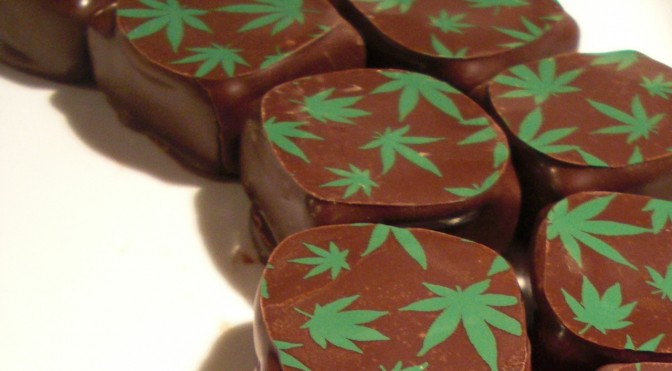Smart Munchies: Great Snacks for Marijuana Consumers

It’s not all about Doritos or Ben & Jerry’s whenever you get hunger pangs while high. Here are good instructions for cannabis butter and recipes that will satisfy your craving for sweet and salty treats.
By Cheri Sicard
Everyone knows that stoners and the munchies go together like cops and donuts. Yes, the mainstream media stereotypes everyone. But just as lots of cops will pass on Krispy Kreme with nary a glance, the snacks of choice for many stoners have no connection whatsoever to Taco Bell or Cheese Whiz.
Today’s discriminating stoners want snacks as sophisticated as their stash. Salty? Sweet? Spicy? Crunchy? Creamy? The tastiest, most tantalizing snacks contain two or more of these attributes. No matter what you’re craving, the recipes below have got you covered.
Let’s start with the seemingly at-odds duo of salty and sweet—which, when combined in just the right proportions, create a delicious flavor combo that teases the taste buds and dares you to take just one more bite to figure out which flavor element you prefer. Salted Caramel Corn is a perfect example. In fact, I highly recommend making a second, unmedicated batch, since everyone is guaranteed to want more. The Sweet and Spicy Nutty Snack Mix recipe adds the element of heat. Lastly, my Salted Lime Tortilla Chips with Mango Avocado Salsa combines all these elements, with the bonus of the salsa’s creamy texture to offset the crunch of the chips.
Canna-Butter and Canna-Oil How-To
 Before you can make the recipes in this article, you’ll first need to make cannabis-infused butter and/or oil. Forego the bad advice you often see on the Internet that tells you to grind your plant material in a food processor or coffee grinder before using it to make butter or oil. Those sticky THC-laden trichomes you want to extract are on the plant, not in it. Ground plant material is more difficult to strain and gives your finished product an unwanted increased herbal flavor and darker green color.
Before you can make the recipes in this article, you’ll first need to make cannabis-infused butter and/or oil. Forego the bad advice you often see on the Internet that tells you to grind your plant material in a food processor or coffee grinder before using it to make butter or oil. Those sticky THC-laden trichomes you want to extract are on the plant, not in it. Ground plant material is more difficult to strain and gives your finished product an unwanted increased herbal flavor and darker green color.
To Make About 1 Cup of Cannabis-Infused Butter or Oil, You Will Need:
1-1/4 cups unsalted butter or cooking oil of your choice
1 oz. average- to high-quality trim or low-quality dried bud; or 1/2 ounce average-quality dried bud
About 4 cups water
Why do I include water as an ingredient? Three reasons:
It ensures the cannabis will never reach a higher temperature than the boiling point of 212 degrees F.
Chlorophyll and terpenes—the parts of the plant that give it its flavor and color—are water-soluble. In practical terms, this means a lot of unwanted herbal flavor and green color can be flushed away with the water after cooking, instead of infusing them into the finished marijuana butter or oil. Using water won’t eliminate green color and herbal flavor, but it can reduce it.
Without water in the mix, the plant material tends to absorb too much of the butter or oil. This means usable product is going into the trash, a problem that’s reduced or eliminated by adding water.
Slow Cooker Method (preferred):
Add butter or oil, plant material and water to the slow cooker, and cook on low for about 6 to 8 hours.
Stovetop Method:
Add butter or oil, plant material and water to a large lidded Dutch oven on the stovetop. Bring to a boil, reduce heat to very low and simmer for 6 to 8 hours. Take care to monitor the liquid level often, adding water as necessary in order to always keep at least 3 cups in the pot. Simmering marijuana on the stovetop is very aromatic: If you’re worried about nosy neighbors, cook other strong-smelling foods (such as garlic) at the same time. Better still, use a slow cooker.
Drain and Strain:
The draining procedure is the same for the stove  top and slow-cooker methods. Place a cheesecloth-lined colander over a large pot or bowl, and pour the liquid through to strain. Before discarding the plant material, pour a large kettle full of boiling water over the full strainer in order to wash through any extra butter or oil clinging to the plant material. Allow the plant material to cool, then squeeze out as much liquid as possible. Discard the plant material. Now chill the water and oil, or water and liquid butter. The fats will rise to the top.
top and slow-cooker methods. Place a cheesecloth-lined colander over a large pot or bowl, and pour the liquid through to strain. Before discarding the plant material, pour a large kettle full of boiling water over the full strainer in order to wash through any extra butter or oil clinging to the plant material. Allow the plant material to cool, then squeeze out as much liquid as possible. Discard the plant material. Now chill the water and oil, or water and liquid butter. The fats will rise to the top.
Butter solidifies when chilled, making it easy to simply lift the piece off and discard the water below. Oil will rise to the top of the water, but often won’t solidify. No problem: Use a spoon to skim the oil off the water. Even better is a kitchen gadget called a gravy separator that looks like a small pitcher with the spout originating on the bottom. This unique design allows the water to be poured out while retaining every drop of the oil floating at the top. During the Thanksgiving and Christmas holidays, gravy separators are sold everywhere, otherwise you can find them at gourmet shops, or extra-large ones at restaurant supply stores.
Strain the butter or oil through cheesecloth a second time to remove as much sediment as possible (this step is optional). To strain butter, melt it, strain, then chill again until solid. Refrigerate infused butter or oil until ready to use, or freeze for even longer storage. Fats can still go rancid in the freezer, so try to use within three months.
You’re now ready to start cooking with canna-butter and canna-oil.
Salted Caramel Corn
Portion out this salty-sweet snack, otherwise eating too much is a guarantee. Use an air popper, regular popcorn maker or the stovetop to make the popcorn for this recipe—follow the directions on the popcorn package and those that came with your appliance. Avoid microwave popcorn (it usually has many added flavors and salts).
3 quarts (12 cups) plain popped popcorn
1/4 cup canna-butter
1/4 cup butter
1 cup packed dark brown sugar
1/4 cup honey
2 teaspoons salt (preferably sea salt), divided
3/4 teaspoon baking soda
1 teaspoon vanilla or maple extract
Preheat oven to 225 degrees F. Pop popcorn and set aside. Line 2 large baking sheets with parchment paper or, alternately, grease generously with butter and set aside.
In a medium saucepan over medium heat, melt canna-butter and butter. Stir in the brown sugar, honey and ½ teaspoon salt, and cook, stirring, until mixture comes to a boil. Lower heat to a simmer and, if you have a candy thermometer, cook until mixture reaches 250 degrees F, otherwise you can get close by cooking for about 1-1/2 minutes. Remove from heat and quickly stir in baking soda and extract, which will turn the mixture into a light-brown froth. Working quickly before the caramel cools and starts to harden, pour this mixture over the popcorn in a large bowl, and toss and stir to evenly coat the corn. Spread caramel-coated popcorn in a single layer on the prepared baking sheets and sprinkle on the remaining 1-1/2 teaspoons of salt. Bake for 15 minutes, stir mixture to break up big pieces and return to oven for 15 more minutes. Let cool slightly before serving. For longer storage, cool completely and place in an airtight container for a week or so.
Yield: 12 Cups
Servings: 4
Find more recipes and information in the full article by Cheri in Freedom Leaf Magazine digital edition here
Dosage Warning
The dosing amounts in these recipes are only suggestions. Each person should carefully ingest cannabis according to his or her own needs and tolerance levels. For more dosing information go to: cannabischeri.com.
Cheri Sicard is the author of The Cannabis Gourmet Cookbook and Mary Jane: The Complete Marijuana Handbook for Women. She’s on the board of directors of Orange County (CA) NORML.

